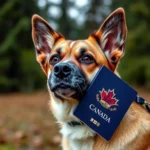
The incredible world of dogs is filled with remarkable traits, but one of their most astonishing abilities is their sense of smell. Understanding this unique capacity not only enhances our appreciation for these furry companions but also plays a significant role in their training, companionship, and even our daily interactions. In this exploration of dogs’ sense of smell facts, we’ll delve deep into the anatomy, functions, and fascinating capabilities of canine olfaction.
The Anatomy of a Dog’s Nose
Structure of the Canine Nose
A dog’s nose is a marvel of biology, intricately designed for the purpose of smell. The canine nasal cavity is significantly larger than that of humans, featuring a complex system of turbinates—bony structures that increase surface area for olfactory receptors. This anatomical setup allows dogs to detect an array of scents with astounding precision.
In comparison, humans have a far simpler olfactory system. The human nose houses approximately 5 million olfactory receptors, while dogs boast an impressive 220 million. Additionally, the olfactory bulb, responsible for processing smells, is proportionally larger in dogs than in humans, indicating their heightened smelling abilities.
Types of Smell Receptors
Dogs possess a diverse array of smell receptors, each tuned to different scent molecules. This specialization enables dogs to detect and differentiate between smells that are undetectable to humans. The major types of receptors include:
- Type A receptors: These are activated by a wide range of odor molecules, allowing dogs to sense various scents in their environment.
- Type B receptors: These receptors are more specialized and can detect specific chemical compounds, enhancing their ability to identify particular smells.
This intricate network of receptors explains why dogs can identify and track scents with such accuracy.
How Dogs Use Their Sense of Smell
Natural Instincts and Hunting
From the moment they are born, dogs rely on their sense of smell for survival. In the wild, their ability to detect scents helps them hunt for food and avoid predators. Breeds such as Bloodhounds and Beagles are particularly renowned for their strong hunting instincts, developed over generations of selective breeding for scent tracking.
These breeds can follow a scent trail that is days old, showcasing the remarkable capabilities of their olfactory systems. In fact, a Bloodhound’s sense of smell is so acute that it can track a person’s scent across distances of over 300 miles!
Communication Through Scent
Beyond hunting, dogs also communicate with each other through scent. They leave scent marks as a way to convey information about their presence, reproductive status, and territory. Pheromones, chemical signals that trigger social responses in members of the same species, play a pivotal role in canine social behavior.
When dogs greet each other, they often sniff each other’s behinds, a behavior rooted in their instinct to gather information about one another. This form of communication is essential for establishing social hierarchies and relationships among dogs.
Tracking and Detection
One of the most remarkable applications of a dog’s sense of smell is in tracking and detection work. Dogs are trained for various roles, including search and rescue, narcotics detection, and even bomb detection. Their ability to distinguish between different scents allows them to locate missing persons, detect illegal substances, and assist law enforcement in various capacities.
Real-life examples of dogs successfully using their sense of smell abound. For instance, search and rescue dogs are often deployed after natural disasters to locate survivors buried under rubble. Their keen olfactory abilities allow them to detect the unique scent of human beings, even when buried under debris.
Fascinating Facts About Dogs’ Sense of Smell
Sensitivity to Scents
One of the most astounding dogs’ sense of smell facts is their sensitivity. Dogs can detect certain substances in concentrations as low as parts per trillion. To put this into perspective, they can smell a drop of liquid in an Olympic-sized swimming pool! This extraordinary ability far surpasses that of humans, who can only detect scents in concentrations of parts per million.
The Science Behind Smell
The science behind how dogs process scent is equally fascinating. When dogs inhale, air flows through their nostrils and into their nasal cavity, where it encounters millions of olfactory receptors. The Jacobsen’s organ, also known as the vomeronasal organ, enhances their ability to detect pheromones, allowing them to perceive scents that are invisible to humans.
This organ works in conjunction with their olfactory receptors, enabling dogs to create a rich mental image of their environment based on smell alone. The process of scent detection involves a series of complex chemical reactions that ultimately lead to the brain interpreting the signals as distinct odors.
Unique Scent-Related Abilities
Dogs possess unique abilities that extend beyond basic scent detection. Research has shown that certain breeds are capable of detecting diseases such as cancer and diabetes. For instance, studies have indicated that dogs can detect cancerous cells through scent alone, often with a higher accuracy rate than traditional medical tests.
Breeds such as Labrador Retrievers and German Shepherds have been successfully trained to recognize the scent of insulin, alerting diabetic owners when their blood sugar levels drop dangerously low. This incredible capability underscores the potential of dogs as medical alert companions.
Practical Applications in Daily Life
Enhancing Training with Scent
Incorporating scent work into dog training can provide significant benefits for both dogs and their owners. Engaging your dog’s natural instincts through scent training can enhance their focus, improve obedience, and foster a deeper bond between pet and owner. Here are a few tips to get started:
- Scent games: Hide treats around your home or yard and encourage your dog to find them using their nose. Gradually increase the difficulty as they improve.
- Tracking exercises: Create scent trails using treats or toys and encourage your dog to follow the scent to a reward.
- Scent discrimination: Teach your dog to differentiate between various scents by using items with distinct smells.
These activities not only provide mental stimulation but also allow dogs to engage in their natural behaviors, promoting overall well-being.
Using Scent for Safety and Security
The sense of smell can also enhance home safety and security. Dogs are naturally alert and can detect unusual scents or changes in their environment. Here are a few ways to utilize your dog’s keen sense of smell for security:
- Alerting to intruders: Many dogs can sense the presence of strangers long before humans can, providing an early warning system against potential intruders.
- Detecting hazardous substances: Some dogs can be trained to identify harmful chemicals or gas leaks, providing a valuable safety measure in homes.
By leveraging their olfactory skills, dog owners can enhance their personal safety and peace of mind.
Engaging Activities for Dogs
Engaging your dog’s sense of smell through various activities can lead to a happier, healthier pet. Here are some fun activities to stimulate your dog’s olfactory senses:
- Scent trails: Create simple trails using food or toys, leading your dog on a fun scavenger hunt.
- Treasure hunts: Hide your dog’s favorite toy or treat and encourage them to use their nose to find it.
- Scent work classes: Enroll in specialized training classes that focus on scent work, allowing your dog to explore their natural instincts in a structured environment.
These activities not only provide physical exercise but also mental stimulation, ensuring your dog remains engaged and fulfilled.
Myths and Misconceptions About Dogs’ Sense of Smell
Debunking Common Myths
There are several common myths surrounding dogs’ sense of smell that need clarification. One prevalent misconception is that all dogs have the same sense of smell. In reality, scent detection ability varies significantly between breeds. Bloodhounds, for example, are renowned for their exceptional tracking abilities, while other breeds may not possess the same olfactory prowess.
Another myth is the belief that scent training is straightforward and simple. Training a dog to use its nose effectively requires patience, consistency, and an understanding of canine behavior. It is essential to approach this training with an appreciation for the dog’s natural instincts and abilities.
The Impact of Environment on Scent
Environmental factors can significantly impact a dog’s ability to smell. Pollution, strong odors, and other contaminants can interfere with their olfactory senses. It’s crucial for dog owners to maintain a healthy environment to support their pets’ natural abilities. Here are a few tips to enhance their scent work environment:
- Minimize strong odors: Reduce the presence of strong perfumes or cleaning products that may mask natural scents.
- Provide fresh air: Ensuring good ventilation in your home can help maintain a healthy environment for your dog’s sense of smell.
- Limit exposure to pollutants: Try to avoid areas with heavy pollution or strong chemical smells when walking your dog.
By being mindful of these factors, you can create an environment conducive to your dog’s olfactory abilities.
Conclusion
The unique capabilities of dogs’ sense of smell are nothing short of extraordinary. From their anatomical structure to their practical applications in daily life, understanding these dogs’ sense of smell facts enriches our relationship with these loyal companions. By engaging with our dogs using their natural instincts and abilities, we can foster deeper connections and enhance their overall well-being. Embracing the power of scent not only benefits our dogs but can also lead to a more fulfilling and enriched lifestyle for both pets and owners alike.
FAQs
1. How much better is a dog’s sense of smell compared to humans?
Dogs have approximately 220 million olfactory receptors compared to humans’ 5 million, allowing them to detect scents in parts per trillion.
2. Can all dog breeds smell equally well?
No, scent detection varies by breed. Bloodhounds and Beagles are known for their exceptional tracking abilities, while other breeds may not possess the same level of olfactory sensitivity.
3. How do dogs detect diseases?
Dogs can detect diseases like cancer and diabetes through their keen sense of smell, often identifying specific scent markers associated with these conditions.
4. What activities can I do with my dog to engage their sense of smell?
You can engage your dog’s sense of smell through scent games, tracking exercises, and even enrolling in scent work classes that focus on enhancing their olfactory skills.
5. How can environment affect my dog’s sense of smell?
Environmental pollutants and strong odors can interfere with a dog’s ability to detect scents. Maintaining a clean and fresh environment is essential for supporting their natural abilities.









